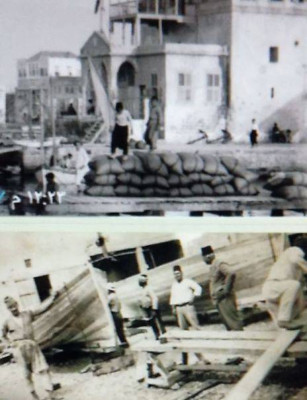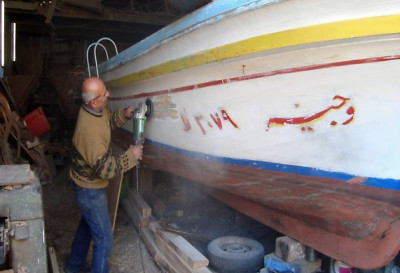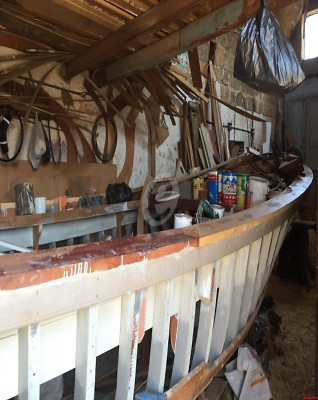Fishing Boats Construction
 Lebanon’s coastal towns are a testament to the country’s deep-rooted connection to the sea. Fishing has been a cornerstone of these communities for generations, providing food and livelihoods, although its importance has declined in recent decades. Shipbuilding in Lebanon’s coastal cities, particularly Tyre and Byblos, including the construction of fishing boats, is believed to date back to Phoenician times. The craft has been passed down from generation to generation, and today traditional boat-building workshops still exist in cities such as Saida, Tyre, and Tripoli.
Lebanon’s coastal towns are a testament to the country’s deep-rooted connection to the sea. Fishing has been a cornerstone of these communities for generations, providing food and livelihoods, although its importance has declined in recent decades. Shipbuilding in Lebanon’s coastal cities, particularly Tyre and Byblos, including the construction of fishing boats, is believed to date back to Phoenician times. The craft has been passed down from generation to generation, and today traditional boat-building workshops still exist in cities such as Saida, Tyre, and Tripoli.
 In these workshops, it’s typically men from the same family who build the fishing boats, sometimes with the assistance of hired workers. These men have usually inherited their workshops, or at least their know-how, from their fathers. In Tyr, for example, the Barbour family is known for building wooden ships and buildings. In 2014, Georges Barbour took over his father Elie’s business when he retired. During his career, Elie Barbour is said to have built most of the fishing boats in Tyr. In the port of Sidon (Saida), Nasser Accad works with his brother and son in another boat-building workshop. Nasser also learned the craft from his father, a Palestinian carpenter who fled to Lebanon in 1948 after working in Jaffa, Palestine, and then Egypt. In Anfeh, fishermen do not build their own boats, which are usually commissioned in Tripoli, but some are skilled at repairing them.
In these workshops, it’s typically men from the same family who build the fishing boats, sometimes with the assistance of hired workers. These men have usually inherited their workshops, or at least their know-how, from their fathers. In Tyr, for example, the Barbour family is known for building wooden ships and buildings. In 2014, Georges Barbour took over his father Elie’s business when he retired. During his career, Elie Barbour is said to have built most of the fishing boats in Tyr. In the port of Sidon (Saida), Nasser Accad works with his brother and son in another boat-building workshop. Nasser also learned the craft from his father, a Palestinian carpenter who fled to Lebanon in 1948 after working in Jaffa, Palestine, and then Egypt. In Anfeh, fishermen do not build their own boats, which are usually commissioned in Tripoli, but some are skilled at repairing them.
 Despite the modernization of the fishing fleet in recent decades, wooden fishing vessels known as feluccas are still used today. The term “felucca” comes from Arabic. It’s a generic term used throughout the Mediterranean that has come to represent a range of small (between 7 and 15 meters long), light, long, narrow vessels with sails and oars, mainly used in the Mediterranean basin. Although the shape of the feluccas remains more or less the same, the models vary. Within Lebanon, each port has its preference: for example, smaller boats are preferred in Tyre, and boats with roofs are preferred in Beirut. These boats are made of wood, usually quina. The first piece to be built is the keel. The ribs of the boat are then attached to it with strong nails. Traditionally, the wooden parts were cut by hand, but nowadays electric saws are used. This makes the building process much faster. The wood is coated with about six coats of petroleum oil to prevent corrosion. The resulting boats are very durable and can withstand the elements. They have a lifespan of at least 20 years and can carry 10 to 20 kg of fish. It takes about two months to build a single boat.
Despite the modernization of the fishing fleet in recent decades, wooden fishing vessels known as feluccas are still used today. The term “felucca” comes from Arabic. It’s a generic term used throughout the Mediterranean that has come to represent a range of small (between 7 and 15 meters long), light, long, narrow vessels with sails and oars, mainly used in the Mediterranean basin. Although the shape of the feluccas remains more or less the same, the models vary. Within Lebanon, each port has its preference: for example, smaller boats are preferred in Tyre, and boats with roofs are preferred in Beirut. These boats are made of wood, usually quina. The first piece to be built is the keel. The ribs of the boat are then attached to it with strong nails. Traditionally, the wooden parts were cut by hand, but nowadays electric saws are used. This makes the building process much faster. The wood is coated with about six coats of petroleum oil to prevent corrosion. The resulting boats are very durable and can withstand the elements. They have a lifespan of at least 20 years and can carry 10 to 20 kg of fish. It takes about two months to build a single boat.
Unfortunately, this trade is in danger of disappearing due to a decline in demand for this type of boat. This is due in particular to the decline in the number of fish in the sea as a result of pollution and fishing with explosives. The modernization of fishing fleets also threatens the preservation of ancestral fishing traditions.

